A red tail Boa is among the most popular snakes in captivity. They are undemanding snakes that get big enough to be impressive but not so big they can kill you – always a plus in a pet. But when shopping for a Red-Tailed Boa you may find yourself overwhelmed by choices.
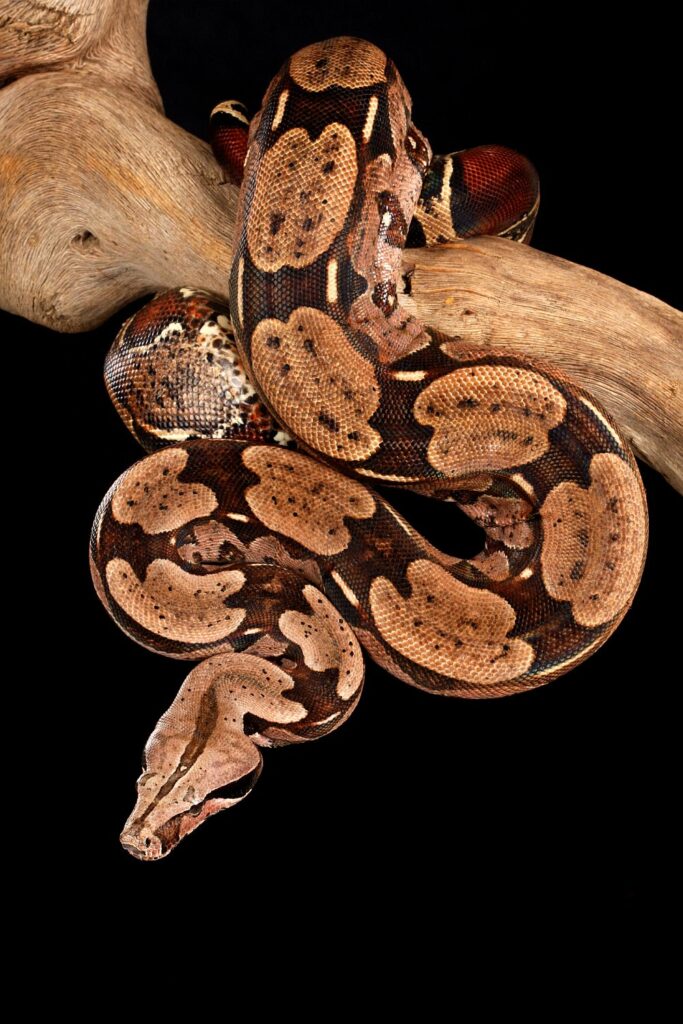
First, you have a choice of what sort of Red-Tailed Boa you want. Red-Tailed Boas come in a wide range of morphs and designer morphs, with beautiful color and pattern variations. But things get even more complicated when you learn just how many different species of Boa are being sold as “Red-Tailed Boas.”
Dogs, coyotes, and wolves are all members of the genus Canis. But if you try raising a coyote or wolf pup as a dog you will soon learn they are not the same.
The various Boa constrictor (and Boa imperator) snakes have different care requirements. Knowing which species or subspecies you have will help you to best meet their needs.
This article will introduce you to the various morphs of the Red-Tailed Boa, as well as the various species that are sold in the trade as Red-Tailed Boas. We will discuss their differences, and tell you how to give your Red-Tailed Boa the best possible home and diet.
Quick Navigation
Species of Red Tailed Boa
Until recently all the Boa Constrictors found throughout South and Central America were considered to be members of the species Boa constrictor. Smaller island and Central American boas were classified as Boa constrictor imperator, a subspecies of the larger South American boas.
In a September 2016 Molecular Phylogenetics and Evolution article, Darren Card used DNA analysis to separate the Boas into three species and numerous subspecies. Boa sigma, found in the Sonoran Desert, is rarely found in the pet trade. The Red-Tailed Boas most available are:
Boa constrictor sub-species
The Boa constrictor species and its subspecies can be found throughout South and Central America.
Boa constrictor constrictor (Red Tail)
- Found in Brazil, Suriname, Guyana, Peru, Venezuela, Colombia, Trinidad and Tobago.
- Suriname B.c.c. Boas are among the largest. A big Suriname female can get as much as 12 feet long!
- Guyana Boas are slightly smaller with males at five to six feet and females around seven to ten feet.
- Brazil and Venezuela prohibit the export of B.c.c. and very few Brazilian or Venezuelan Boas are found in the pet trade.
- Peruvian B.c.c. Boas are often sold as “Iquitos Boas” after the capital of the Amazonian province in which they are found. They are known for their speckling and females will hit nine to ten feet.
- While B.c.c. are found in Colombia. Most Colombian boas in the trade are Boa imperator captured in the northwestern region near the Panamanian border.
- Trinidad B.c.c. are darker than Suriname Boas but similar in size and rarely found in the pet trade.

Boa constrictor constrictor is a large, heavy-bodied snake. While they are not quite so massive as their distant cousins the Anacondas, a B.c.c is definitely a big responsibility – with an emphasis on “big.” A ten-foot-long constrictor is nothing to take lightly.
A wild-caught B. c. constrictor will likely be a defensive animal who will strike at you. Luckily, most B.c.c.’s in the pet trade today are captive-bred and less likely to fear human contact. But though they may not attack you, they still bite their food before squeezing. And if they mistake you for food you may be in for a painful surprise.
While there are no reports of B. c. constrictors killing an adult human, a feeding bite from a big B.c.c. can send you to the emergency room for stitches. An adult female B.c.c. will likely need a six-foot and possibly an eight-foot cage.
Before you purchase a baby B.c.c. make sure you understand the commitment to house and feed a big adult.
Boa constrictor longicauda (Long tail)
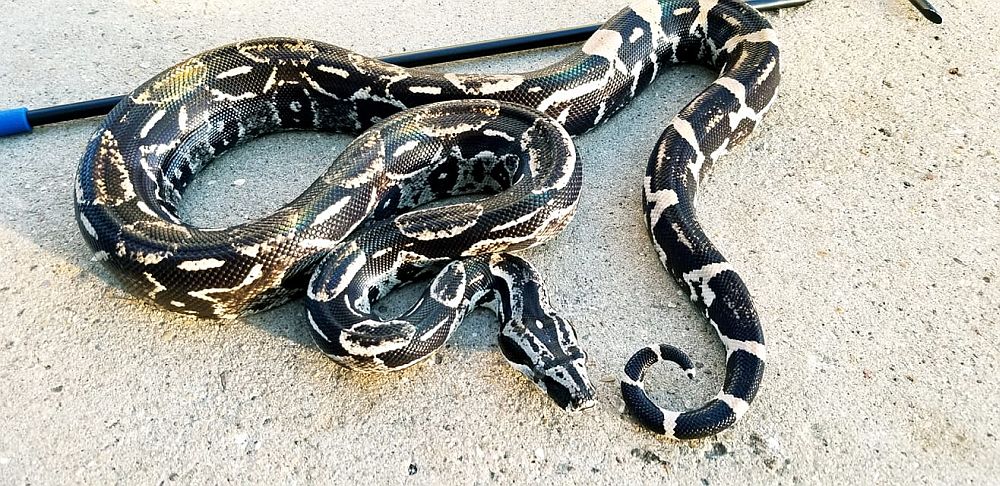
- Found in Tumbes province of northern Peru
B.c.longicauda has a black and white or black and gold pattern with war paint stripes over their eyes and an arrow mark on the top of their head. As adults most Longicaudas range from blueish gray or harvest gold with black saddles to almost entirely black with charcoal grey/blue heads.
Longicauda Boas (also called “Peruvian Longtails”) live in a mountainous region with cooler temperatures than the steamy jungles where B.c.c. is found. They will do best with an 86 degree hotspot and 76 degrees in the cool spot. B.c.longicauda is also smaller than B.c.c., with most females topping out around 7 feet.
Longicauda Boas are among the most laid-back boas, and make excellent pets for people who want a beautiful smaller boa. And if you can find a pair of pure B.c.longicauda and breed them, you are doing everyone a service. Habitat destruction and human development threaten B.c.longicauda in the wild.
Boa constrictor occidentalis
- Found in Argentina and Paraguay.
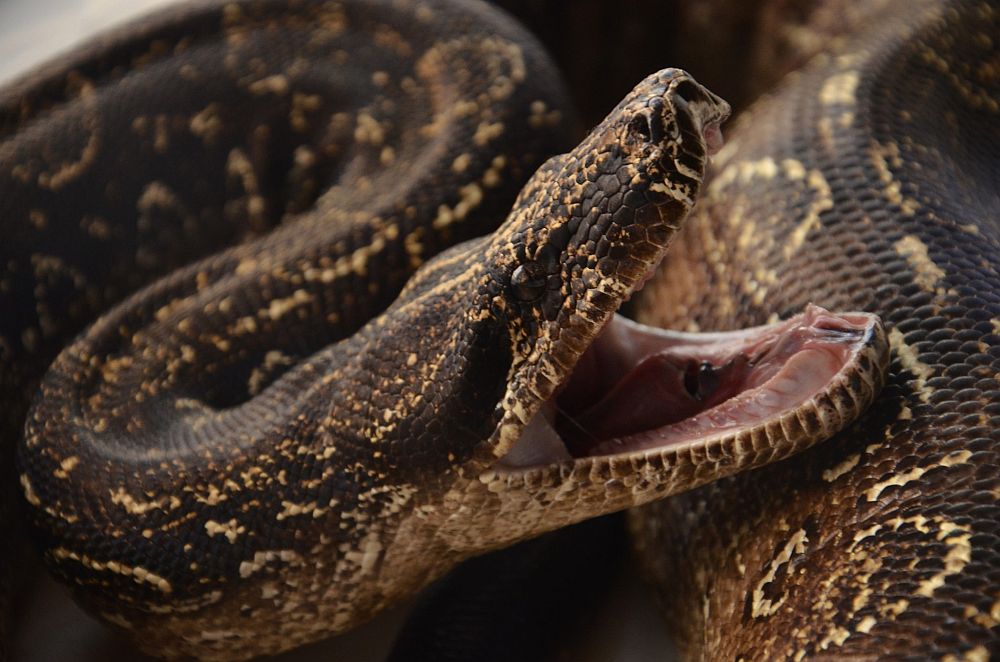
B.c.occidentalis, the Argentine Boa, replaces the bat-wing and hourglass saddles of their northern relatives with white rosettes on a speckled black background. They are beautiful, docile, and generally healthy eaters. Be sure not to handle your Argentine Boa when there are food smells in the area and remember that a cat or puppy may smell like food to a big snake!
Like Longicaudas, Argentine Boas live in mountainous terrain. But while both are pressed by human development, the Argentine Boa has lost nearly 90% of its territory. Since 1987 the Argentine Boa has been listed in the wild as CITES Appendix 1 – the last step before “Endangered.” This has stopped their export but done little to keep humans off their territory.
Because they do not have bright tails, Argentine Boas have never become as popular as Red-Tailed Boas with snake keepers. They are still lovely snakes who take handling well. If you can provide a 5-foot or 6-foot cage (female Argentine Boas can get nearly 11 feet long), you may find an Argentine Boa a lovely and easy to maintain big snake.
Boa constrictor imperator
- Found throughout Central America and northwestern Colombia.
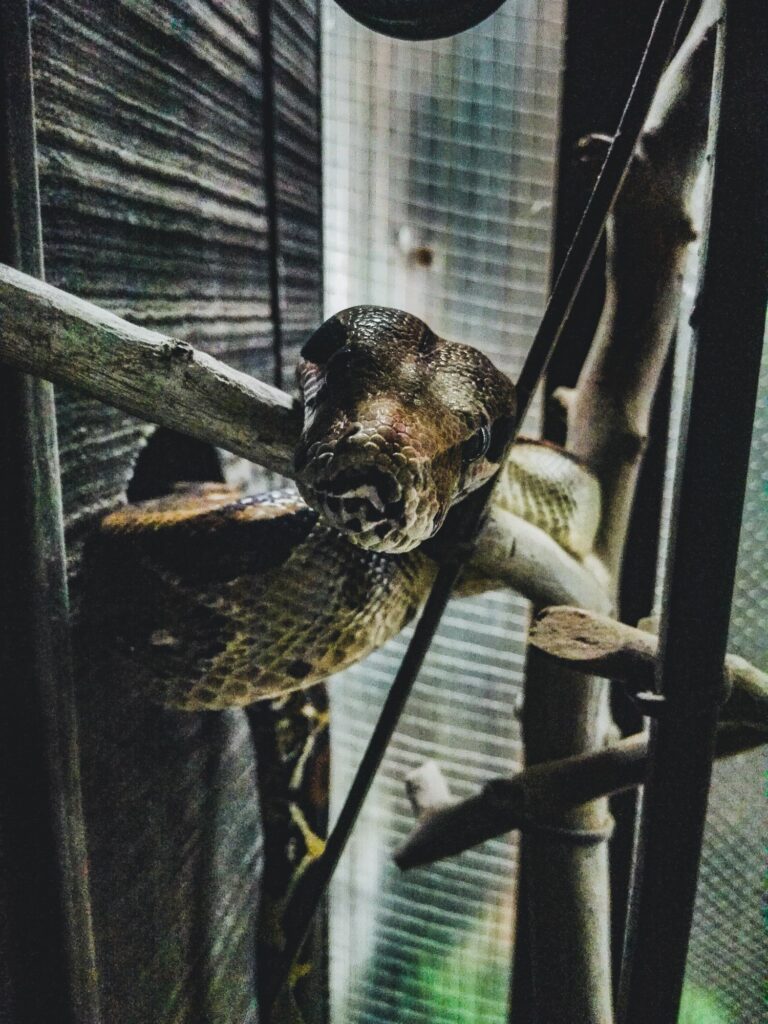
Most of the Red-Tailed Boas found in the pet trade are largely or wholly B. imperator. They are considerably smaller than B. constrictor: Males generally grow to four or five feet and females rarely grow over seven feet. And there are several insular (island) subspecies that are even smaller.
The Boa imperator found on Cayo Cochinas (Hog Islands) in Honduras have little black pigment and a speckled salmon-orange background. The biggest females are around six feet and males three to four feet. Hog Island Boas have been bred with other Boas to produce color morphs, so many “Hog Island Boas” may get slightly larger.
A Boa imperator will not get as big as a pure-blooded B. constrictor. But historically few captive breeders distinguished between the various species and frequently bred B. constrictor with Colombian B. imperators. While your B. imperator will fit in a 4-foot cage its entire life, there is a chance a female B. imperator x constrictor may outgrow it.
Boa sigma
- Found in Mexico’s Sonora desert
The Sonoran Desert Boa, also sold as the Tarahuama Desert Boa, is the smallest boa constrictor available. German breeder Erika Stöckl successfully bred a female Tarahuama at 38 inches — most female Red-Tailed Boas are not ready to breed until they are at least six feet long.
The small boas on Mexico’s Pacific Coast were originally named Boa sigma. Later they were reclassified as a subspecies of B. imperator. Then genetic testing proved that the first taxonomists were right all along.
The “Leopard” morph originated in a clutch of Sonoran Desert Boas. These Leopards have been crossed out to other Red-Tailed Boas. While the Leopard morph generally remains on the small side, a B. sigma x imperator or B sigma x constrictor will be larger than the Sonoran Desert Boa.
Red-Tailed Boa Morphs
Red-Tailed Boas are among the most popular snakes in the pet trade and many pattern and color morphs are available. Some Red-Tailed Boa Pattern Morphs include:
- Aztec
- Jungle
- Leopard
- Motley
- Sterling (Patternless)
A few of the many color morphs include:
- Albino
- Anery
- Blood
- Caramel Albino
- Hypomelanistic
Red-Tailed Boa Breeders have also created many interesting morph combinations. A Sunglow Red-Tailed Boa expresses both the Albino and Hypomelanistic genes, while a Ghost has both the Anerythistic and Hypomelanistic genes.
Red Tail Boa Care
Below we’ll be looking at the most important things for caring about your Red Tailed Boa, from housing to heating, feeding, and handling of your new pet.
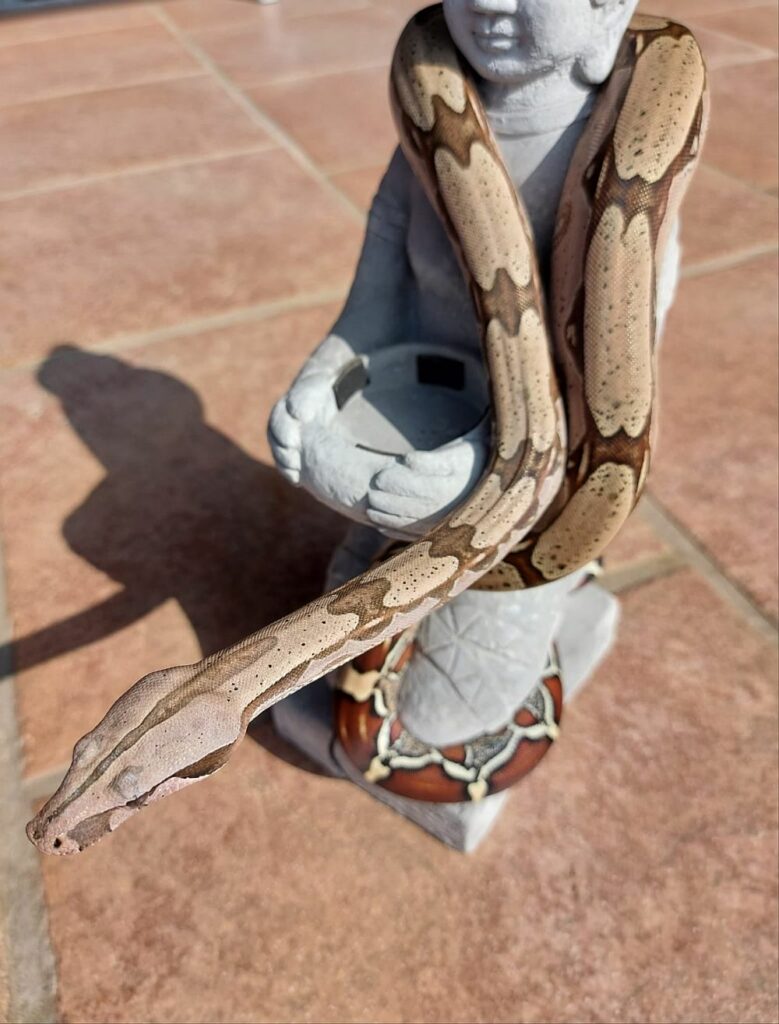
Housing Your Red-Tailed Boa
When they are born – Boas are born live, not hatched – a baby Red-Tailed Boa is between 15 and 20 inches long. You can keep a baby Boa in a 20-gallon tank, but only for a short time. Within a year your Red-Tailed Boa will be over three feet long: by age three it will be near its full growth of five to seven (or more) feet.
Adult boas should be kept in a four-foot enclosure: B. sigma and smaller B. imperator may be OK in a three-foot terrarium, but since Red-Tailed Boas enjoy exploring in an enriched environment, you will never go wrong with a larger tank.
B. Constrictor males will need a four-foot to five-foot enclosure. A B. constrictor female should have at least a five-foot enclosure. Six feet will be better, and a mammoth female may even need an eight-foot cage!
Boas are muscular snakes that kill by constriction. Make sure they cannot lift the top off their home. Keeping a weight atop their container, or making sure it is securely fastened, can help prevent an escape.
In their native environment, Red-Tailed Boas climb trees to escape predators and find feathered food. They will take full advantage of any climbing branches you add to their home. They will also appreciate hides on both the warm and the cool sides of their tank. This will allow them to feel secure no matter where they choose to thermoregulate.
Give your Red-Tailed Boa a heavy water dish that is big enough to soak in but not so big that your snake might have trouble getting a drink. Your Red-Tailed Boa will soak for relaxation or when shedding. Make sure your Boa always has clean water: if your municipality uses chlorine or other chemicals, you should give your snake bottled water.
If they are not breeding, your Red-Tailed Boas should be kept one in a cage. They may become stressed from company and will feel much more secure having their own room.
Substrate for your Red-Tailed Boa
Newspapers or paper towels make a suitable, cheap and easy to replace substrate for Red-Tailed Boas. (If you use newspaper, make sure your paper is black and white. Color newspaper is less absorbent and the inks can bleed onto your snake).
While many Red-Tailed Boa keepers swear by this method, others favor more attractive solutions. Reptile carpet is convenient, attractive, and easy to clean in cold tap water. Red-Tailed Boas do not burrow, so they will not try to get under their substrate.
If you want to use a substrate of wood shavings, make sure it is aspen. Pine and cedar shavings contain toxic oils which are bad for a snake’s health. Wood chips and sand can cause intestinal blockages if your Red-Tailed Boa ingests them along with his meal.
Check your Red Tailed Boa’s home every day and spot-clean any droppings you find. If you are using newspaper or paper towels you will have to tear the tank down and replace all the paper every time your Red-Tailed Boa leaves a package. Other substrates should be replaced completely at least once a month.
Whatever substrate you use, make sure your Red-Tailed Boa’s cage is kept clean. A dirty cage can lead to scale rot, infections and other problems.
Heating a Red-Tailed Boa’s Cage
Your Red-Tailed Boa needs a warm side and a cool side to thermoregulate. The heat source should be on one end of the cage, not in the center. This lets your Red-Tailed Boa decide when to warm up and when to cool down.
The temperatures in the cool end should generally stay between 75 to 80 degrees. The warm spot should be around 85 degrees with a 90-degree hot spot provided by an under-tank heating device.
If your room is warm enough, you can turn off the heating at night. This provides the temperature variation Red Tailed-Boas experience in their native environment. So long as their cage temperature stays above 72 degrees or so they will benefit from slightly cooler nights.
Feeding a Red-Tailed Boa
A juvenile Red-Tailed Boa should have a rat every five to seven days. The smallest will take pinkies or fuzzies. As they mature you can move them up to rat pups. When your Red-Tailed Boa reaches its first birthday and is between three and four feet long you can start feeding them a weaned or small rat every ten to fourteen days.
Adult Red-Tailed Boas over two years old and four feet long will typically take a small to medium rat every two weeks. Because females are larger, you can give them large or jumbo rats. And if you have an especially large female Red-Tailed Boa you may even feed her small rabbits.
Lack of exercise and ready access to food makes many captive snakes obese. In the wild Red-Tailed Boas regularly go weeks or months without eating. Your Red-Tailed Boa will be happiest with an appropriately sized meal served at proper intervals.
Boas are also less tolerant of high-fat meals than Pythons. Since many of the largest rats sold in the pet trade are “Zucker rats” genetically predisposed to obesity, they may make your Red-Tailed Boa fat or cause regurgitation. If your Red-Tailed Boa outgrows large rats, consider switching to leaner rabbits rather than XXL or XXXL rats.
Handling Your Red-Tailed Boa
Red-Tailed Boas are curious snakes who love to explore. Occasional handling can be beneficial for the snake and owner alike. They are not as wriggly as Corn Snakes or more slender snakes, but they will give you a surprisingly strong hug if they are startled.
Avoid handling your Red-Tailed Boa while it is in shed. Snakes in shed have cloudy eye caps which limit their vision. As a result, they tend to be cranky and defensive while shedding. Even the most placid Red-Tailed Boa may strike at you if you try handling it during a shed.
Also, try not to handle your Red-Tailed Boa for 48 to 72 hours after it eats. During that time your Red-Tailed Boa is digesting its food. Disturbing it may cause regurgitation, which is messy and can injure or even kill your snake.
Your baby Red-Tailed Boa may be snappy at first. In the wild, baby Red-Tailed Boas are food for a number of predators, so they are understandably nervous. Don’t force the issue. In time your baby Red-Tailed Boa will learn you are not a threat.
When picking your Red-Tailed Boa up, never grab it by the tail! Picking a snake up by its tail can dislocate vertebrae and lead to crippling injuries. Always pick your Red-Tailed Boa up from the mid-body and provide support with both hands.
Red Tail Boas As Pets: Conclusion
Red-Tailed Boas make an excellent snake for beginners who understand their little snake may grow up to be bigger than expected. Understand that within a few years your little snake may require a large and expensive container.
Red Tail Boa for Sale
You will do best getting your Red-Tailed Boa from a breeder who can tell you about your prospective pet’s parents and ideally grandparents. There is no way of knowing where that Red-Tailed Boa in a pet store came from or how large it will get. It is safer to get your Red-Tailed Boa from people who specialize in the species.
If you decide to go with a smaller boa, make sure you buy from a reputable breeder whose snakes are pure island boas. Cutting Edge Herp offers pure Hog Island Boas and Longicauda Boas. Brian Boas also offers a selection of pure locality boas.
You can find many breeders and Red-Tailed Boa owners on Facebook’s Boa Constrictor Fanatics. They will be able to provide you advice on your new Red-Tailed Boa and help ensure your Red-Tailed Boa stays comfortable, happy, and well-housed for decades to come.